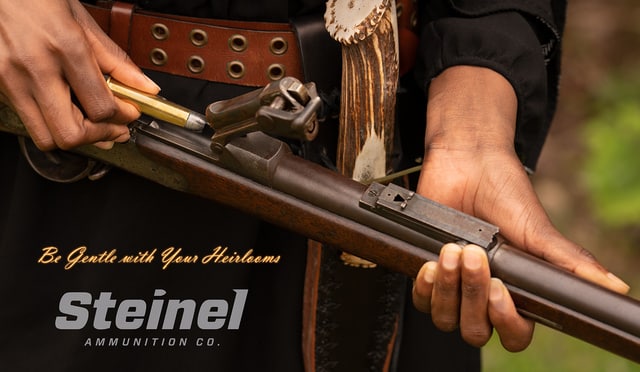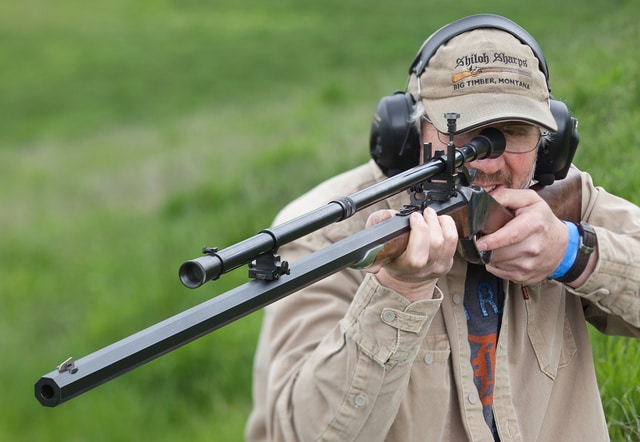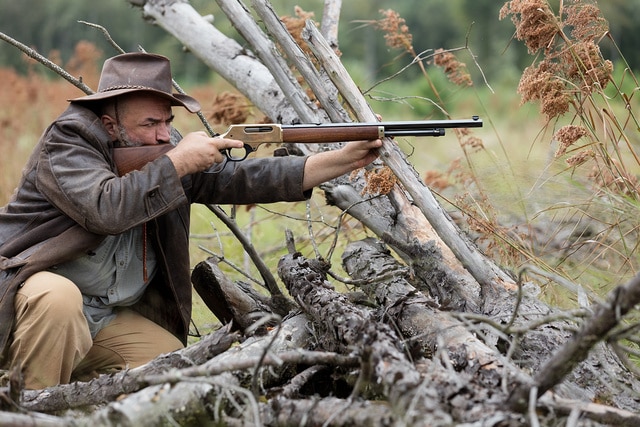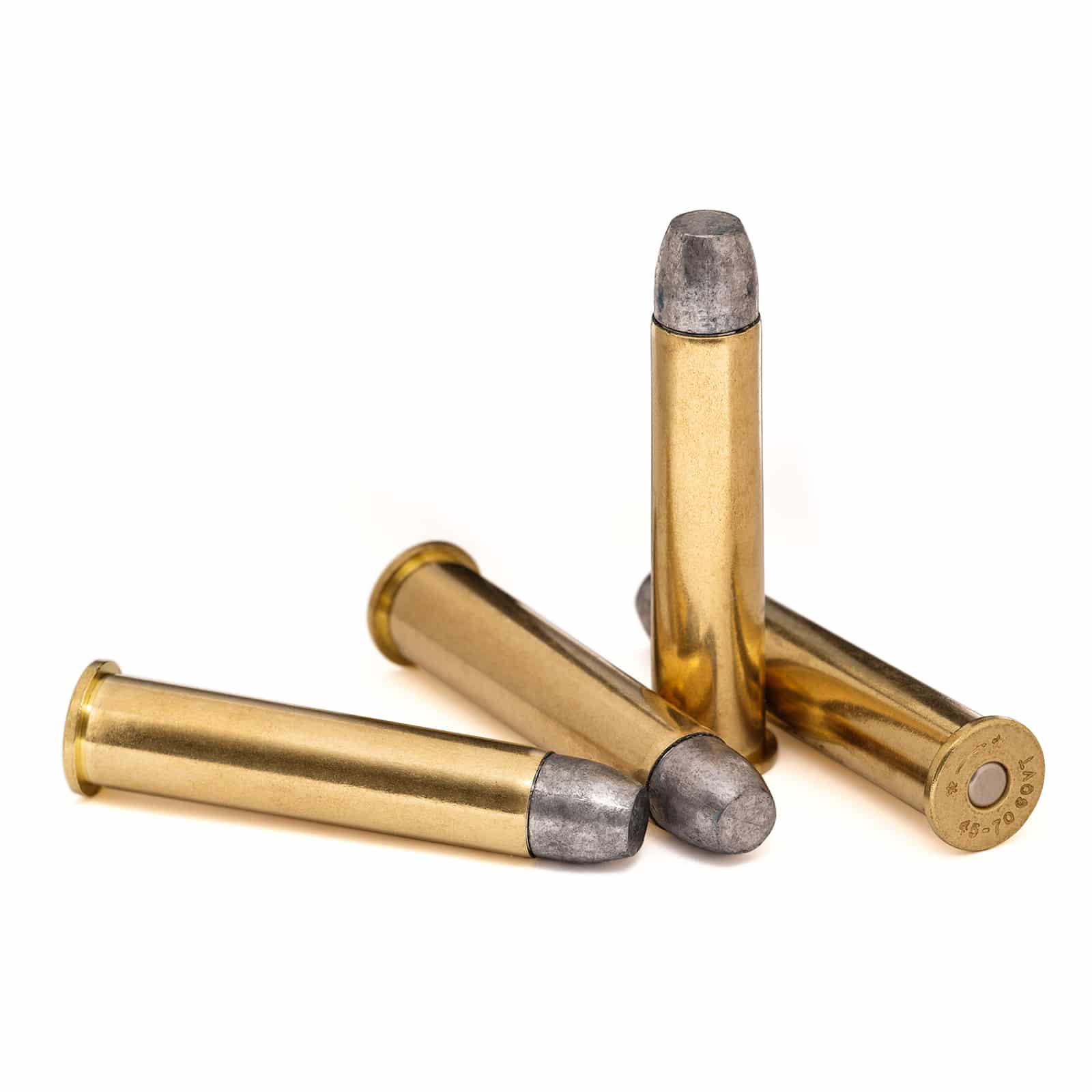
45-70Govt is available commercially in plinker loads, much like 38S&W and 44-40Win. More impressively, almost a century and a half after its inception, a wide variety of hunting and precision 45-70Govt loads are also manufactured by companies large and small. As a result, historic artifacts like Springfield “trapdoor” rifles can be put to regular use even with new production low-pressure smokeless cartridges. Modern production variations on lever, falling block and bolt actions are still being introduced. This continued popularity stems from two factors, a minor technical one and a major political one.

The minor factor is the simplicity of safe reloading of this cartridge. Unlike most of the 1880s ammunition, it uses a straight wall case. Reloading it is as simple as working with a typical pistol cartridge, perhaps even simpler because of the sheer volume of the powder uses. 70 grains of black powder may be measured by weight or by volume, and making a small error is not critical. Loading with smokeless requires a little more attention to detail, and only the relatively mild original-power cartridges should be used in Springfield Trapdoor originals or reproductions, as well as the 19th century rolling blocks or lever actions. Modern Sharps and lever action reproductions, also 45–70 Gibbs Mauser conversions can stand stronger loads. Most modern lever actions and Ruger #1 falling block can hold up to even the maximum pressure supported by the case design: 300gr JHP at 2050fps or heavier bullets at a slightly lower velocity. Some commercial loads go beyond the original 500 grains, offering a very stable long-range bullet, though one that requires very careful range estimation.

But the technical factors alone cannot account for the retained popularity, especially since it has no effect on the factory production. And yet 45–70 remains available in far greater variety and at a fraction of the price of its once competitors. The main reason for this popularity is political: Americans have traditionally owned real guns. Not just small-bore shotguns made from surplus Russian Berdans or French Tabatière army rifles, but proper, long-range rifles equally suited for stopping a grizzly, anchoring a buffalo or putting daylight through the hearts and minds of hostile humans at a standoff distance. Unlike governments of most other countries, Switzerland being a conspicuous but small-scale exception for most of its history, the United States government sold off much of the army inventory to afford the newer and better gear. As that practice declined after 1968, taxes went up instead to buy more military gear while destroying surplus and obsolescent guns. But Springfield “trapdoor” rifles were sold off to the public in large numbers, and the popularity of the caliber made it popular with civilian gun makers. This became a self-reinforcing cycle that continues today. The main brake on the popularity of this caliber is the modern copy-cats, the rimless 450 Marlin and the rebated rim 458SOCOM, both of which promise the performance envelope of the modern 45–70 without having to worry about customers chambering the full power ammunition in the more fragile antiques. 450 Marlin delivers on that promise, while 458SOCOM hangs with the mid-range loads at most. 44 Magnum, although impressive performer in its own right, falls short with half the bullet weight at the same velocity or 750fps slower with the same projectile.



The 45-70 cartridge is the only American cartridge that can substantiate the fact that it was indeed a viable option in all three of our American old west eras. Those eras include our Cowboy Era, our Buffalo Era, and our Indian Wars Era. The 45-70 started off in 1873 with the Springfield single shot being modernized from the older 1865 design in 50-70. A 45-70 repeating rifle didn’t start with the 1886 Winchester, nor with John Marlin’s model 1881. The first repeating 45-70 was made by Whitney for Andrew Burgess. Burgess wanted to present a fighting rifle for the US Army issue fighting rifle trials of 1878. Burgess didn’t win the contract in 1878 but it was still an excellent 45-70 levergun.
I am Spanish and I am in love with the .45-70 that I shoot in my Marlin 1895G, with which I hunt wild boar at night or deer during the day. By the way, I didn’t expect it, but it groups the 325 grain Hornady FTX extraordinarily well.
I have been enjoying my 45-70 in a Ruger #3 for years now. It just happens to be produced in 1976 (200 years of American freedom), and the year I married the most wonderful woman in the world.
Just got my ammo delivered for my 45-70 old Trapdoor carbine. So happy to be able to hit the range again. Been a year to get the loads, (panic buying has caused shortages in components) but they are the best to shoot in my old gun. As always, every round is carefully put together for a sure-fire safe load.
Anybody that has one of these older Trapdoor rifles this company makes the best ammo loaded for these old guns. IMO. My old gun groups with this ammo under 4 inches at 200 yards. Can’t wait to go and kill some wild bores with it. The all lead bullet will tear them a new rear end!
I had a S&W 500 H&R Handi Rifle ; SOLD iT and got a 45-70 H&R Handi Rifle, and I feel MUCH better noW!
I have a Remington 1895 GBL. Absolutely love the thing. Does not feel good on a bench without a shooting vest but, standing, the slow hard kick is manageable. I bought 300 rounds of over pressure ammo from Steinel and it took roughly a year and a half to come in due to COVID. Good stuff and now I have roughly a lifetime supply because it is so easy to reload. You had a very good article. Inside 150 yards, I personally will always pull the 45-70 out of the closet for the rest of my life. It is a venerable weapon.
Great article very fun gun to shoot. Mines a Henry side gate and got a deer with it third day out!
Yes, I am a fan of the old 45-70 Government cartridge. I own three Marlins (two Guide Guns and an 1895SS), a Ruger No. 1, a Browning M1885 BPCR rifle, and a late production “Trap Door” Springfield which went to Cuba in 1898 with the 1st US Volunteer Infantry. I use bulk Remington 300-gr JHP bullets for plinking in the Marlins and Ruger. A case full of IMR 4198 will just about reach 2400 fps with those light bullets. The BPCR is only for lead bullets and usually propelled by compressed black powder loads. I do not shoot the collectable antique rifle. I do recommend heavy 400-gr to 500-gr solid bullets for possible defense against big bear with the Marlin Guide Guns–to disrupt the central nervous system with well placed shots.
A side note regarding the popularity of the .45-70: When it was introduced, every US gunmaker was attempting to get on the bandwagon (see, for example, the history of the 1886 Winchester) – in contrast, I seem to recall that British African authorities had prohibited the use of sporting arms in .45 calibre (something about ensuring that supplies in the event of a native rebellion would be limited in rebel hands).
Many cartridges have come and gone over the decades…but some cartridges simply have “staying power.” Primarily because they are very effective at the tasks they were designed for. “If it ain’t broke, don’t fix it” applies here. Similar articles could be written on the .45 Colt, the .30-30, .30-06 and maybe even the .38 Special. All are well over 100 years old, but common items that can be found on the ammo shelves of most any gun shop.
I’m far from an expert on the .45/70 Govt., but have been off / on user of it. My friend’s Dad owned a H&R “Shikari” single shot break open rifle way back in the 1980’s. One shot from it and I was transformed. A bit hard on the shoulder due to light weight and drop of stock, but not as bad as I thought – more of a shove than a jolt. Cool !
My current .45/70 is a single shot Super 16 T/C ported factory barrel. Mounted on the T/C carbine butt stock, a small feral hog carbine that does not weigh you down and still hits with authority. So my guess for the .45/70 longevity – because it works and works well !
Thanks for the article.